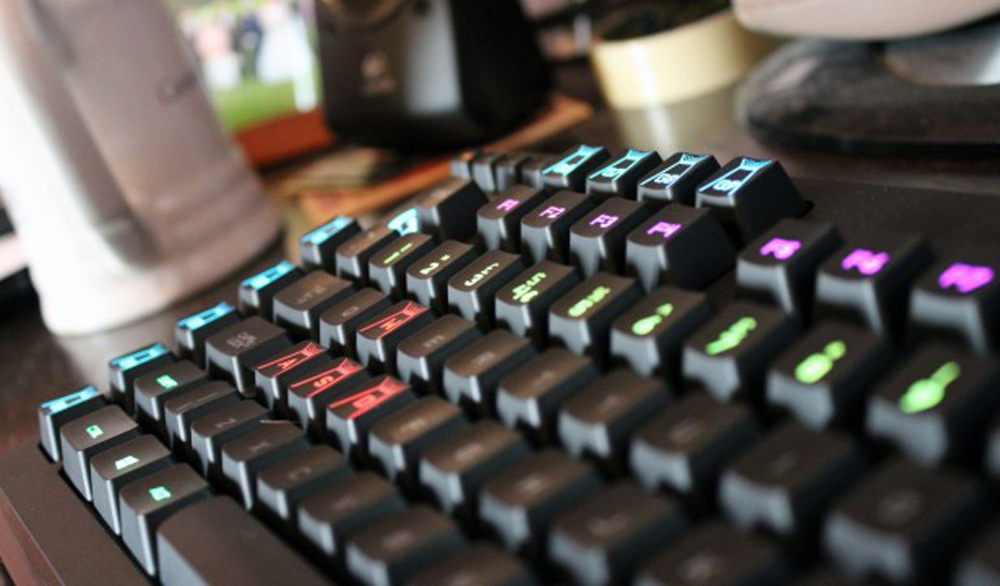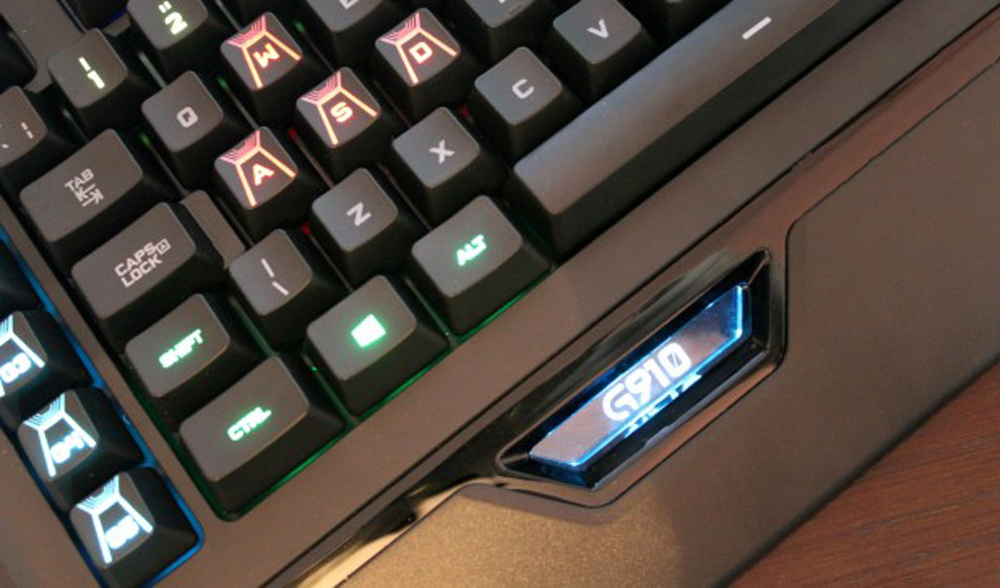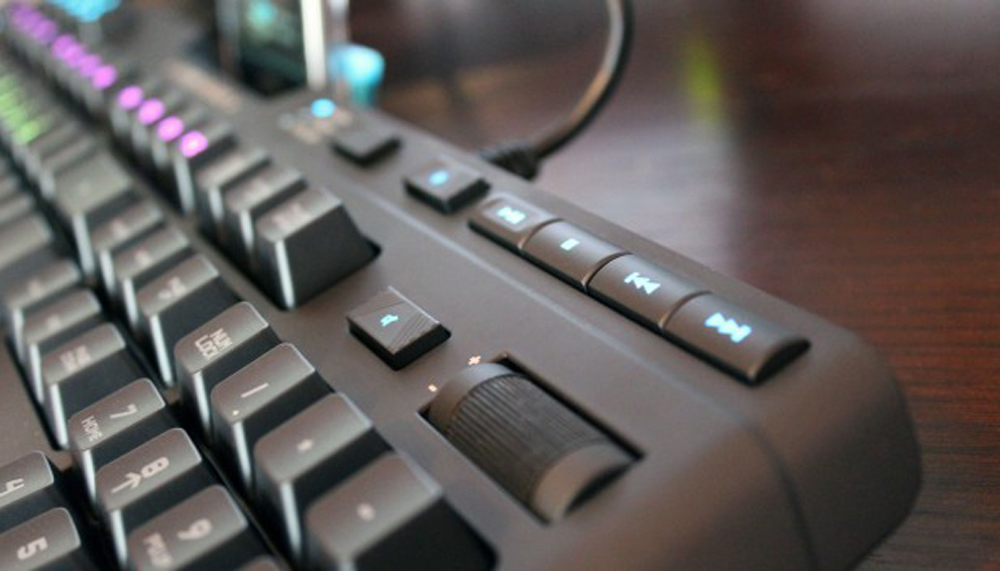PROS
- Good typing experience
- Robust and stylish plastic design
- Nine macro keys
- Media controls
CONS
- Hit-and-miss smartphone features
- Cherry MX keys would be preferred
- Weirdly placed shortcut keys
KEY FEATURES
- Omron Romer-G mechanical switches
- RGB backlighting
- Nine macro keys
- Android and iOS companion app
- Media controls, volume roller, number pad
- Manufacturer: Logitech
- Review Price: £128.00
WHAT IS THE LOGITECH G910 ORION SPECTRUM?
Gaming keyboards are big business, with numerous companies trying to tempt cash out of gamers’ pockets – and that means they’re also willing to take a gamble with new features to try to make products stand out.
The Logitech G910 Orion Spectrum takes a couple of big risks. It’s only the second keyboard I’ve seen to include proper smartphone integration, and it also abandons Cherry MX hardware for another brand of mechanical switch.
LOGITECH G910 ORION SPECTRUM – DESIGN AND FEATURES
Smartphone integration is a relatively new feature on keyboards – the Roccat Skeltr is the only other unit I’ve seen with similar functionality.

The Logitech has a small dock on its back edge that slides back to accommodate a smartphone or a small tablet, and the corresponding Arx app is available on Android and iOS.
The app links to the keyboard and its PC wirelessly, and has some familiar features: one screen has CPU, GPU and RAM speeds and temperatures; another has media controls. The G910’s nine macro buttons can be programmed with basic commands in the Arx app, and game profiles can also be chosen. If you have a Logitech mouse, that can be monitored from within the app, too.
It sounds great, but in practice it’s underwhelming. The macro programming screen is slow, with the Windows app offering a greater number of options. The media tools are slow, too – especially considering the keyboard has its own media buttons. Hardly any games officially support the app’s in-game display feature.
I’m not impressed with the dock, either. There’s no USB charging facility, so battery drain is a concern, and it’s flimsy – pressing my phone saw the handset and the dock bounce back and forwards. The dock is open on either side, so a nudge could send a smartphone tumbling.

Quite honestly, it’s easily outclassed by the Roccat offering. That keyboard had a wider, sturdier dock and worked with devices being placed sideways, which means there’s less chance of your phone obstructing the view of your screen. It uses USB, so devices can stay charged, and the Skeltr features a button to switch to Bluetooth – so you can use the keyboard to reply to messages on your smartphone.
Roccat’s companion app offers similar modes to the Logitech, but it serves up a greater number of PC statistics and lighting options, battery-saving options, mistakes-per-hit monitoring and more.
The Roccat app has proven on occasion to suffer from being slow, just like the Logitech – but there’s no contest: the Roccat’s dock is better, and its companion app is more comprehensive.
Look beyond the smartphone integration and the Logitech continues to be unconventional. It doesn’t use Cherry MX mechanical switches, instead opting for Romer-G switches, which are made by Omron.
Logitech says that these buttons are lighter and easier to press than their mechanical counterparts, thanks to a modest 45g actuation force and a 1.5mm actuation distance, which is less than most other switches.
The Romer-G switches are designed to have a softer, lighter action than most, which brings them directly up against the Roccat’s rubber-dome technology. The Roccat isn’t mechanical, but its membrane design promises softer, quieter typing than mechanical units.
Logitech’s device impresses with a 70-million key press longevity rating. That’s 10 million more than the Roccat, and 20 million more than many Cherry MX units.
Elsewhere, the Logitech has some good features – but also some notable omissions.

Those nine macro buttons can be switched between three different profiles with small buttons in the top-left corner, and there’s a gaming key on the right-hand side that disables the Windows button. There’s RGB lighting and 113-key anti-ghosting.
A volume roller and a full set of media keys are also included, alongside a button that disables the backlight – although I’d have preferred it if it cycled through brightness levels.
There aren’t any USB or audio connections, however, and only the macro keys are programmable – potentially an issue for gamers. The cable isn’t braided, which is unusual for a keyboard in this price bracket.
The keyboard is largely made from plastic, but build quality is excellent, and its lights, cut-away sections and wide design is more sensible than silly. The closest thing to stereotypical gaming extravagance is found in the odd, futuristic pattern on top of the key gaming buttons. This keyboard is big, too: 505mm wide and 1.5kg on the scales.
LOGITECH G910 ORION SPECTRUM – SOFTWARE
The Logitech Gaming tool has all of the usual options in different tabs. The first allows for macro programming, with an easy interface for skipping around the keys and different modes. The tool scanned my system for installed games and loaded relevant commands – a handy touch – and macro recording was simple.
The second tab offers a similar layout for creating, saving and modifying profiles, and the third window provides lighting options. Every key can be customised, or groups of buttons can be tweaked – by default, this highlights the WASD, cursor, function, number keys and other important gaming groups. Different games can illuminate different keys, and eye-catching animated patterns are available.
The last tab is a heat-map tool that can be used to monitor key presses. It’s useful for competitive gamers, but less enthusiastic players won’t need it.
Logitech’s software is intuitive, but the Roccat Skeltr provides more audio options and tools for working with Alienware devices. It can even turn in-game events into dynamic lighting effects on the keyboard, if you’re into that sort of thing.

LOGITECH G910 ORION SPECTRUM – PERFORMANCE
The G910’s mechanical switches are designed to offer a different kind of typing performance. True to form, the Romer-G hardware is instantly different from the usual Cherry MX Reds or Browns.
It’s smooth, with markedly less travel – and the keys hit the metal base of the keyboard with a softer click than Cherry MX-based devices. The keys are consistent and comfortable, with no difference in feel between normal buttons and the larger keys such as Space and Return.
The keys have a tiny tactile bump about 2/3 of the way down, but it’s barely noticeable – I only found it when I went looking. In the midst of an intense gaming session, it won’t be noticeable.
The sleek action, softer feel and quieter noise sees the Logitech fall between the smooth and more definite action of Cherry MX Red switches and the Roccat keyboard, which used its rubber dome design to deliver a softer feel and even less travel than the Logitech.
The Logitech feels like a half-way house between mechanical units and rubber-dome devices. Its soft, smooth action is fantastic for typing, and absolutely fine for most games – but competitive or more traditional players will prefer the more solid and snappy feel of a Cherry MX switch.
I have one small layout quibble: the macro keys. They’re divided into two banks, with five buttons on the left and four above the function row. Those latter buttons are tricky to reach, and the mode-changing buttons are even smaller and further away.

SHOULD I BUY THE LOGITECH G910 ORION SPECTRUM?
The G910 Orion is an odd and inconsistent device that ultimately falls short.
Its key feature is smartphone integration, but it’s riddled with issues. The flimsy dock lacks charging, and the app limps through with sluggish, basic features. Elsewhere, there are macro keys, media buttons and RGB backlighting, but a lack of programmable buttons or USB ports.
The absence of Cherry MX switches is notable, too. The Logitech Romer-G switches are good enough for typing and gaming, but the soft and shallow typing action just isn’t as snappy or as satisfying as Cherry MX hardware. It’s better than the spongy Roccat, but hardcore gamers will likely prefer a more traditional feel – especially for this amount of money.

The Logitech is an awkward keyboard that’s left floundering in the middle of the market. The Roccat has it beaten for features and smartphone integration, and proper Cherry MX devices are better if a solid typing experience is your preference. The G910 offers a decent typing experience and some useful features, but it has too many downsides to earn a recommendation.
VERDICT
Logitech makes bold claims about the expensive G910, but it misfires in several areas. The smartphone integration is underwhelming, and its lack of USB ports and fully programmable keys mean that this RGB-lit unit just doesn’t do enough to justify its high price.

Sourse: trustedreviews.com




































